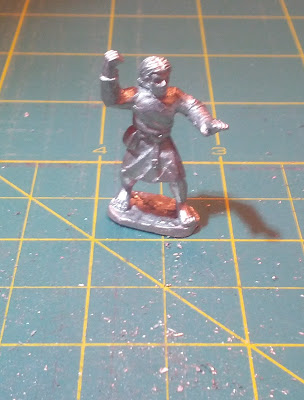So I've opted for the Army Painter method. I've tried a different technique for each of my three sample Scots levy. I've dipped one figure in the Army Painter 'Strong Tone' QuickShade. While I like the idea of the QuickShade, I'd love to find a less toxic option. To that end I've also dipped a figure in an IKEA water-based wood stain. For the third figure I brushed on some Army Painter Dark Tone ink that came bundled with my starter Warpaints set. I felt like brushing gave me more control, but the dipping and flinging was strangely satisfying. Let's see how they came out.
Here are group shots of before and after (sorry the camera on my phone isn't more consistent):
The differences vary dramatically by technique. Let's start on the left side and work our way right.
This gent was done with just the ink wash. He's still flat (which is nice) but he isn't protected by a coat of varnish either. Kind of a mixed bag. The fingers came out nicely. Not much detail on the face though. The tunic looks pretty good although there seem to be some "tide marks" along the bottom. All-in-all a pretty subtle shading effect.
This fella was done with the water-based IKEA varnish. He's glossy (but protected!) and the shading effects are very pronounced. Maybe too shaded. I feel like the brownish varnish stuck over all the surfaces, not just the folds and crevices. Perhaps that means the varnish needs diluting? It's inconsistent as well. There are big areas on his legs and tunic that seem untouched. Not too fussed about this one.
This last guy was done with the Army Painter dip. I'm pretty happy with this one. He's the glossiest of the bunch. A little too much varnish in most places. That part is pretty hard to control with the dip method. I think for my next test I'll try brushing on the Army Painter Strong Tone. Many sources suggested this, but I wanted to try the dip method for several reasons. One, it looked kind of fun. Two, it seemed easy. Three, I didn't have to mess with turpentine to clean brushes.
Lots of learnings here. I think brushing is the way to go. I definitely need to use less stain. I also think my base colors could go lighter since they are going to be muddied up pretty well by the stain. I guess it's off to buy some turpentine (or some disposable brushes!). I think I'll toss these guys in some degreaser and start fresh.
Another bit of good news. I'm off to see my first SAGA game tomorrow. A local group of historical gamers are meeting to play at a hobby shop about an hour way. Hoping to find something closer, but it's a start!















